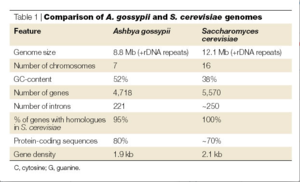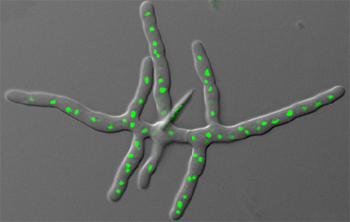Ashbya gossypii: Difference between revisions
| Line 20: | Line 20: | ||
[[File: GenomeComparison.png|thumb|right| A comparison of the genomes for ''Ashbya gossypii'' and ''Saccharomyces cerevisiae.'' 2013[http://www.nature.com/nrmicro/journal/v3/n5/fig_tab/nrmicro1148_T1.html Nature Publishing Group] ]] | [[File: GenomeComparison.png|thumb|right| A comparison of the genomes for ''Ashbya gossypii'' and ''Saccharomyces cerevisiae.'' 2013[http://www.nature.com/nrmicro/journal/v3/n5/fig_tab/nrmicro1148_T1.html Nature Publishing Group] ]] | ||
<br> | |||
The genome for ''Ashbya gossypii'' is the smallest genome of a free-living eukaryote thus far, coming up to only 9.2 megabases. It contains a total of 4718 protein-coding genes. As mentioned above, more than 90% of its genes are similar to that of ''Saccharomyces cerevisiae''. | |||
The comparison of these genes reveals shared homology and synteny (the condition of two or more genes being located on the same chromosome) between the two species. | |||
==References== | ==References== | ||
Revision as of 02:07, 8 November 2013
Classification
Higher Order Taxa:
Fungi, Ascomycota, Saccharomycetes, Saccharomycetales, Saccharomycetaceae
Species:
A. gossypii
Description and Significance
Ashbya gossypii (Eremothecium gossypii) is a filamentous fungus, meaning that it is an infectious agent of the fungus kingdom consisting of a long series of attached cells. It is closely related to unicellular yeasts, especially Saccharomyces cerevisiae, a yeast with which it shares more than 90% of its genome.
Genome Structure

The genome for Ashbya gossypii is the smallest genome of a free-living eukaryote thus far, coming up to only 9.2 megabases. It contains a total of 4718 protein-coding genes. As mentioned above, more than 90% of its genes are similar to that of Saccharomyces cerevisiae.
The comparison of these genes reveals shared homology and synteny (the condition of two or more genes being located on the same chromosome) between the two species.
References
- Jaspersen Lab, 2007. "Sue Jasperseon, Ph.D, Profile." Stowers Institute for Medical Research.
- Wikipedia Article "A. gossypii," March 2013. "Ashbya gossypii."
- Ashbya Genome Database, September 2013. "Ashbya gossypii." EnsemblFungi.

